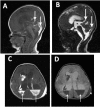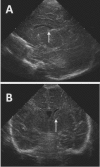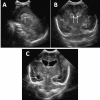A review of the current treatment methods for posthaemorrhagic hydrocephalus of infants
- PMID: 19183463
- PMCID: PMC2642759
- DOI: 10.1186/1743-8454-6-1
A review of the current treatment methods for posthaemorrhagic hydrocephalus of infants
Abstract
Posthaemorrhagic hydrocephalus (PHH) is a major problem for premature infants, generally requiring lifelong care. It results from small blood clots inducing scarring within CSF channels impeding CSF circulation. Transforming growth factor - beta is released into CSF and cytokines stimulate deposition of extracellular matrix proteins which potentially obstruct CSF pathways. Prolonged raised pressures and free radical damage incur poor neurodevelopmental outcomes. The most common treatment involves permanent ventricular shunting with all its risks and consequences.This is a review of the current evidence for the treatment and prevention of PHH and shunt dependency. The Cochrane Central Register of Controlled Trials (CENTRAL, The Cochrane Library) and PubMed (from 1966 to August 2008) were searched. Trials using random or quasi-random patient allocation for any intervention were considered in infants less than 12 months old with PHH. Thirteen trials were identified although speculative interventions were also evaluated.The literature confirms that lumbar punctures, diuretic drugs and intraventricular fibrinolytic therapy can have significant adverse effects and fail to prevent shunt dependence, death or disability. There is no evidence that postnatal phenobarbital administration prevents intraventricular haemorrhage (IVH). Subcutaneous reservoirs and external drains have not been tested in randomized controlled trials, but can be useful as a temporising measure. Drainage, irrigation and fibrinolytic therapy as a way of removing blood to inhibit progressive deposition of matrix proteins, permanent hydrocephalus and shunt dependency, are invasive and experimental. Studies of ventriculo-subgaleal shunts show potential as a temporary method of CSF diversion, but have high infection rates.At present no clinical intervention has been shown to reduce shunt surgery in these infants. A ventricular shunt is not advisable in the early phase after PHH. Evidence exists that pre-delivery corticosteroid therapy reduces mortality and IVH and there may be trends towards reduced disability in the short term. There is also evidence that postnatal indomethacin reduces IVH but with no effect on mortality or disability. Overall, there is still no definitive algorithm for the treatment of PHH or prevention of shunt dependence. New therapeutic approaches in neonatal care, including those aimed at pre-empting PHH, offer the best hope of improving neurodevelopmental outcomes.
Figures




Similar articles
-
Neonatal posthemorrhagic hydrocephalus from prematurity: pathophysiology and current treatment concepts.J Neurosurg Pediatr. 2012 Mar;9(3):242-58. doi: 10.3171/2011.12.PEDS11136. J Neurosurg Pediatr. 2012. PMID: 22380952 Free PMC article. Review.
-
Intraventricular haemorrhage and posthaemorrhagic hydrocephalus: pathogenesis, prevention and future interventions.Semin Neonatol. 2001 Apr;6(2):135-46. doi: 10.1053/siny.2001.0047. Semin Neonatol. 2001. PMID: 11483019 Review.
-
Posthaemorrhagic ventricular dilatation: new mechanisms and new treatment.Acta Paediatr Suppl. 2004 Feb;93(444):11-4. doi: 10.1111/j.1651-2227.2004.tb03041.x. Acta Paediatr Suppl. 2004. PMID: 15035455
-
[Role of Ommaya reservoir in the management of neonates with post-hemorrhagic hydrocephalus].Zhonghua Er Ke Za Zhi. 2009 Feb;47(2):140-5. Zhonghua Er Ke Za Zhi. 2009. PMID: 19573462 Chinese.
-
The initial neurosurgical interventions for the treatment of posthaemorrhagic hydrocephalus in preterm infants: A focused review.Br J Neurosurg. 2016;30(1):7-10. doi: 10.3109/02688697.2015.1096911. Epub 2015 Oct 15. Br J Neurosurg. 2016. PMID: 26468612 Review.
Cited by
-
Treatment Strategies and Challenges to Avoid Cerebrospinal Fluid Shunting for Pediatric Hydrocephalus.Neurol Med Chir (Tokyo). 2022 Sep 15;62(9):416-430. doi: 10.2176/jns-nmc.2022-0100. Epub 2022 Aug 27. Neurol Med Chir (Tokyo). 2022. PMID: 36031350 Free PMC article. Review.
-
Lysophosphatidic acid signaling may initiate fetal hydrocephalus.Sci Transl Med. 2011 Sep 7;3(99):99ra87. doi: 10.1126/scitranslmed.3002095. Sci Transl Med. 2011. PMID: 21900594 Free PMC article.
-
Neonatal posthemorrhagic hydrocephalus from prematurity: pathophysiology and current treatment concepts.J Neurosurg Pediatr. 2012 Mar;9(3):242-58. doi: 10.3171/2011.12.PEDS11136. J Neurosurg Pediatr. 2012. PMID: 22380952 Free PMC article. Review.
-
Navigating the Complexities of Intraventricular Hemorrhage in Preterm Infants: An Updated Review.Cureus. 2023 May 13;15(5):e38985. doi: 10.7759/cureus.38985. eCollection 2023 May. Cureus. 2023. PMID: 37323305 Free PMC article. Review.
-
Effect of delayed intermittent ventricular drainage on ventriculomegaly and neurological deficits in experimental neonatal hydrocephalus.Childs Nerv Syst. 2012 Nov;28(11):1849-61. doi: 10.1007/s00381-012-1848-z. Epub 2012 Jul 6. Childs Nerv Syst. 2012. PMID: 22767377
References
-
- Volpe JJ. Neurology of the newborn. 4. Philadelphia, Pa.; London: Saunders; 2008.
-
- Dobrzańska A, Pleskaczyńska A, Jędrzejczak A, Czech-Kowalska J, Ryciak E, Gruszfeld D. Respiratory distress syndrome and mechanical ventilation as risk factors of severe intraventricular haemorrhages in preterm infants. J Ped Neonatal. 2006;3:43–47.
LinkOut - more resources
Full Text Sources

